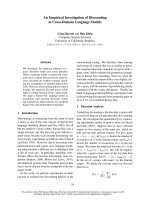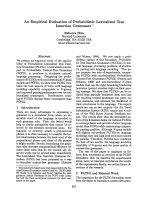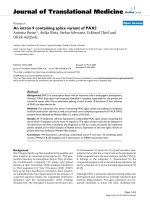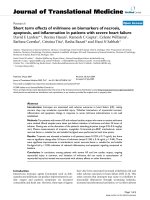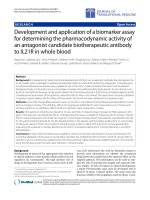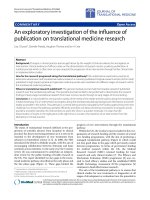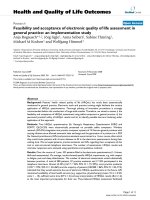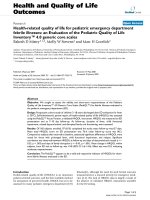Báo cáo hóa học: " An exploratory investigation of the influence of publication on translational medicine research" pot
Bạn đang xem bản rút gọn của tài liệu. Xem và tải ngay bản đầy đủ của tài liệu tại đây (416.44 KB, 5 trang )
Douet et al. Journal of Translational Medicine 2010, 8:62
/>Open Access
COMMENTARY
© 2010 Douet et al; licensee BioMed Central Ltd. This is an Open Access article distributed under the terms of the Creative Commons
Attribution License ( which permits unrestricted use, distribution, and reproduction in
any medium, provided the original work is properly cited.
Commentary
An exploratory investigation of the influence of
publication on translational medicine research
Lisa J Douet*, Danielle Preedy, Vaughan Thomas and Ian A Cree
Abstract
Background: Changes in clinical practice are brought about by the weight of clinical evidence for and against an
intervention. Clinical evidence of efficacy relies on the dissemination of research results, usually by publication in
medical journals which is often seen as a pre-requisite for progression of an intervention through further clinical trials
or implementation studies.
How far has research progressed along the translational pathway?: We undertook an exploratory exercise to
determine where basic and translational medical research is currently published. Original research articles (329 in total)
published in high impact general and specialist medical journals were classified into different stages of research within
the translational medicine pathway.
Where is translational research published?: The general medical journals had the broadest spread of published
research over the translational pathway. The specialist journals tended to be positioned to disseminate the research
findings of early stage translational research from basic science results through to early stages of clinical testing.
Conclusion: It is not possible for one journal to satisfy all the needs of the reader and the author along the translational
medicine pathway. For an intervention to progress along the translational pathway background information should be
readily accessible in the article. This pathway is currently being actively managed by the funding agencies but the next
challenge is to ensure the pathway operates efficiently and does not allow promising innovations to languish and to
provide a smoother transition for interventions to reach the clinic in a quicker timescale. It is clear that the
dissemination of results in the right place at the right time is crucial to the transition of an intervention from the
laboratory to clinical practice.
Introduction
The status of translational research (defined as the pro-
gression of scientific advance from inception to clinical
practice) has drawn increasing attention as it is seen to be
essential to the development of new treatments from
advances in biomedical science [1-5]. In 2006, the NIH
introduced the Bench to Bedside awards, with the aim of
encouraging collaboration between clinicians and basic
scientists across institutes. In the same year the Cooksey
review [6] was commissioned to undertake an indepen-
dent review for the public funding of health research in
the UK. The report identified two key gaps in the transi-
tional medicine pathway, described as the early phase and
the late phase gaps (Figure 1). These gaps limited the
progress of new interventions through the translational
pathway.
Within the UK, the Cooksey report resulted in the reor-
ganisation of research funding and the creation of several
new funding programmes, with the aim of producing a
managed translational pathway (Figure 2) which would
not lose good ideas in the gaps which previously existed
between programmes. In terms of government funding
for medical research within the UK, the Medical
Research Council (MRC) retained funding for basic
research and early clinical studies [7]. The Efficacy and
Mechanism Evaluation (EME) programme [8] was cre-
ated to fund efficacy studies and the established NIHR
Health Technology Assessment (HTA) programme [9]
continues to fund effectiveness research.
The aim of the translational pathway is to ensure that
clinical studies for new treatments or diagnostics at all
stages of development or evaluation have the potential to
* Correspondence:
1
NIHR Evaluation, Trials and Studies Coordinating Centre, University of
Southampton, SO16 7NS, UK
Full list of author information is available at the end of the article
Douet et al. Journal of Translational Medicine 2010, 8:62
/>Page 2 of 5
gain funding. For the purpose of this article the transla-
tional pathway has been divided into four categories of
research; early, efficacy, effectiveness and other. The early
research category covers research and development for
basic discoveries and for new therapeutic/diagnostic/
device/public health intervention (or a new indication for
an existing intervention) from basic science through to
early phase clinical studies with the aim of establishing
proof of concept in humans. The efficacy category
includes all research which aims to establish definitive
proof of efficacy for an intervention (where proof of con-
cept has already been achieved), to the point where, in
Figure 1 Cooksey report research pathway. The Cooksey report identified two gaps in the translation of biomedical science to healthcare: The first
gap arises in the translation of basic and clinical research into ideas and products; the second gap relates to introducing those ideas and products into
clinical practice[6].
Figure 2 The managed translational pathway. This is the managed translational pathway between the MRC and NIHR. The overlap between the
stages is deliberate - it is quite possible that some studies or trials could be funded by more than one body; this overlap is deliberate to ensure that
studies do not fall between gaps. Successful publication and a managed pathway should led to faster translation through this pathway, which cur-
rently van take at least 15 years from discovery to changes in clinical practice.
Managed Translational Pathway
Phase 0 Phase I Phase II Phase III Phase IV Practice
Discovery
Successful
development
Preclinical
HTA
Discovery
Science
Experimental
Medicine
Successful
testing
Clinical Trials
other
MRC
EME
HTA
Timescale (years)
0 15+
Douet et al. Journal of Translational Medicine 2010, 8:62
/>Page 3 of 5
the example of a drug, marketing authorisation could be
sought or widespread use in healthcare supported. The
effectiveness category includes all research which aims to
investigate effectiveness, costs, and the broader impact of
health technologies for those who use, manage and pro-
vide care in the health service. The other research cate-
gory encompasses all research which is not covered by
the previous three categories; research that falls into this
category generally sits further along the translational
pathway and includes service delivery, health service,
global health and public health research as well as epide-
miology and modelling. The challenge is to ensure that
the benefits of translational research are delivered as
changes in clinical practice.
Changes in clinical practice are brought about by the
weight of clinical evidence for and against an interven-
tion. This involves assessment of the quality of the evi-
dence, the risks and benefits of treatments, and the
impact of implementation on clinical care pathways by
practitioners and those determining healthcare policy.
Clinical evidence of efficacy relies on the dissemination
of research results, usually by publication in medical
journals which in academic models is often seen as a pre-
requisite for progression of an intervention through fur-
ther clinical trials or implementation studies. Therefore,
publication of translational research is a critical step -
how and where, results are published will often have an
impact on further progression through the pathway and
can inform research managers where to target their
resources. A recent review identified 101 articles between
1979-1983 in 6 top basic science journals that had appar-
ent promise for development as a major clinical applica-
tion. But over twenty years later, only five of these
promising advances were in licensed clinical use and only
one of them had had a major impact on current medical
practice. Three quarters of the promised interventions
resulting from these basic science papers had not yet
been tested in a randomised trial. The article reported
that the strongest predictor of moving to randomised
experimentation was industry involvement in the original
basic science publication [10]. Clearly, the publicly
funded research system has not been working as effec-
tively as one might wish.
How far has research progressed along the
translational pathway?
Publication is seen as a major output for research, though
clinical impact is its goal, as well as having financial
implications for the research groups involved through
research assessment exercises that often use publications
as a surrogate. It is certainly true that the readership of a
journal varies, and it is possible that in some cases, publi-
cation in specialty rather than general journals may be
more appropriate and influential in the progression of an
intervention. To investigate if this is possible we under-
took an exploratory exercise to determine where basic
and translational medical research is currently published.
Two authors (LD and IC) independently classified orig-
inal research articles (329 in total) published in the high
impact general medicine journals Nature Medicine, New
England Journal of medicine (NEJM) and The Lancet
from July-December 2008 and one month (October 2008
was chosen as it was in the middle of the time frame stud-
ied) of seven high impact speciality journals; American
Journal Respiratory Critical Care Medicine (AJRCCM),
Circulation, Gut, Journal Clinical Oncology, Journal of
Orthopaedic Research, Lancet Neurology and finally
Ophthalmology. The articles were classified into one of
four phases discussed in the introduction; early research,
efficacy research, effectiveness research, and other
research. In some of the papers reviewed the information
needed by the reader to determine where the research sat
along the translational pathway was not always readily
available within the article. Articles over which there was
disagreement over the classification (45 articles, 13.6%)
were independently classified by a further two authors
(VT and DP). Any remaining disagreements over articles
were resolved by discussion between all four authors.
Where is translational research published?
From our exploratory study it has been possible to detect
some early trends in the research published by the
selected journals. The general medical journals, The Lan-
cet and NEJM had the broadest spread of published
research over the translational pathway. In the time frame
investigated the NEJM published more efficacy research
(40% of articles) than early research or effectiveness
research, which combined constituted only 30% of the
articles. Whereas, all stages of translational medicine
were more equally represented in The Lancet. In the
period studied both efficacy and effectiveness research
was well represented in this journal, with each of these
categories contributing 20% to the total number articles
published. The 'other research' category was well repre-
sented by these two journals and although not clearly
demonstrated by figure 3, these were the only two jour-
nals of those selected to provide a forum for global health
research. Both NEJM and the Lancet had the smallest
proportion of original articles devoted to basic science,
which represented 11% and 6% respectively, whereas,
Nature Medicine seemed to be clearly positioned at the
basic science and early clinical studies end of the transla-
tional pathway, with 100% of its articles falling into this
category.
From the limited selection of specialist journals analy-
sed it appeared to be clear that they are positioned to dis-
seminate the research findings of early stage translational
research from the basic science results through to the
Douet et al. Journal of Translational Medicine 2010, 8:62
/>Page 4 of 5
early stages of clinical testing; all journals, with the excep-
tion of ophthalmology, consist of at least 50% early and
efficacy research. Effectiveness research is much less
prevalent in the selected specialist journals with only Cir-
culation and Lancet Neurology publishing a noteworthy
number of these trials at 17% and 25% respectively (figure
3).
Again the other research section is not further analysed
here, but Gut, Circulation, Ophthalmology and Journal of
Clinical Oncology publish a substantial amount of
research in the public health and service delivery aspects
of medicine (figure 3). Epidemiology and modelling con-
tributes a large proportion of the articles published in
Journal of Clinical Oncology and Ophthalmology.
The specialist journals are also limited by how far the
interventions for their speciality are along the transla-
tional pathway, for example orthopaedic research
involves a lot of basic research which is only just starting
to be translated into clinical studies. If this analytical
approach to studying publications were expanded it
seems likely that it could be exploited by research com-
missioners to ensure promising treatments are actively
translated into clinical practice.
Conclusions
It is obviously not possible for one journal to satisfy all
the needs of the reader and the author along the transla-
tional medicine pathway. Even in this small sample of
journals the positioning of the journal in the translational
pathway is likely to affect the chance of an article falling
within the first gap in translation being published in the
journal of choice. The general medical journals The Lan-
cet and the NEJM publish a wide range of research that
reflects the wide ranging readership of the general medi-
cal journals, though the recent study in Science [10] sug-
gests that this may not often translate into practical
medical advances. There is no doubt that the majority of
early translational work is published in the specialist jour-
nals. This article has focused on a select few of the high
impact specialist journals, but there are many more jour-
nals with lower impact factors that have a smaller (and
perhaps more sub-specialist) audience than the largest
specialist journals. It is possible that key research findings
along this pathway may be missed. Important and high
quality work may be lost in these journals if it is not of
more general interest at that moment and is not pursued
by the research group concerned. This is now obviated, to
Figure 3 Primary research article classification: Published primary research articles categorised by research phase (basic and early clinical research,
efficacy research, effectiveness research and other research) as a percentage of the total number of articles for that journal during the period July-
December 2008 for the general medical journals and for October 2008 for the specialist medical journals.
Basic and early clinical research
Efficacy trials
Effectiveness trials
Other research
Basic and early clinical research
Efficacy trials
Effectiveness trials
Other research
100
75
Percentage
50
0
25
Nature
NEJM The
J Clinical
Ophthalmology
J Ortho. AJRCCM Circulation
Lancet
Gut
medicine
Lancet
Oncology
research
neurology
General medical
journals
Specialist medical
journals
Douet et al. Journal of Translational Medicine 2010, 8:62
/>Page 5 of 5
some extent, by the widespread use of search engines,
such as PubMed.
Some of the articles were difficult to categorise, even
with four independent opinions, as the background infor-
mation on the research was not always available, without
searching the references. This has important implications
for the development of the clinical evidence base as some
of the research may be overlooked as it is not clear where
the intervention is along the translational pathway. It is
debatable whether any intervention pursues a linear pro-
gression along this artificial pathway: as often multiple
advances, both scientific and technical, lead to a change
in clinical practice.
However, in our view, it is essential that the managed
translational pathway should prevent the potential loss of
valuable information by actively managing it through the
different stages involved. This pathway is currently being
actively managed by the funding agencies. The focus is
now to ensure that the pathway operates efficiently and
does not allow promising innovations to languish without
a funder, providing a smoother transition for interven-
tions to reach the clinic in a quicker timescale. The chal-
lenge is to ensure that the benefits of translational
research are delivered as changes in clinical practice.
From this exploratory study, it appears that the dissemi-
nation of results in the right place at the right time can be
critical to the transition of an intervention from the labo-
ratory to clinical practice and the medical journals have
an important role in supporting this process. Further
work will needed to draw firm conclusions, but we hope
that these results will provoke thought and discussion as
to how publication could better influence translation of
research into clinical practice.
Summary points
1. Where an article is published mirrors the progres-
sion of an intervention along the translational medi-
cine pathway.
2. The journals chosen appeared to publish work
which is at particular stages along the translational
pathway.
3. To evaluate the progress of an intervention along
the translational pathway it is helpful if previous work
is described to clearly demonstrate where the inter-
vention is within the pathway.
4. The medical journals have a key role alongside the
funders of the managed translational pathway to
ensure interventions move from basic science to clini-
cal practice quickly and smoothly.
Funding statement
This research was carried out by the NIHR Evaluations
Trials and Studies Coordinating Centre. No additional
funding was sought for this research.
Ethical approval
Ethical approval was not required for this research.
Contribution of author
LD and IC were involved in all stages of this study; DP
and VT assisted with classification of articles. All authors
critically reviewed and agreed the final draft. LD and IC
are the guarantors.
Competing interests
All authors declare that the answer to the questions on your competing inter-
est form are all No and therefore have nothing to declare.
Acknowledgements
We are grateful for Professors Rajesh Thakker (Chair EME Programme Board)
and Tom Walley (Director EME programme) and Dr Ruairidh Milne (director of
NETSCC, ERA) for the idea for this work and for the comments provided on the
manuscript.
Author Details
NIHR Evaluation, Trials and Studies Coordinating Centre, University of
Southampton, SO16 7NS, UK
References
1. Duyk G: Attrition and translation. Science 2003, 302:603-605.
2. Sung NS, Crowley WF Jr, Genel M, Salber P, Sandy L, Sherwood LM,
Johnson SB, Catanese V, Tilson H, Getz K, Larson EL, Scheinberg D, Reece
EA, Slavkin H, Dobs A, Grebb J, Martinez RA, Korn A, Rimoin D: Central
challenges facing the national clinical research enterprise. JAMA 2003,
289:1278-1287.
3. Sartor RB: Translational research: Bridging the widening gap between
basic and clinical research. Gastroenterology 2003, 124:1178.
4. Marincola FM: Translational Medicine: A two-way road. Journal of
Translational Medicine 2003, 1:1-2.
5. Ioannidis JPA: Materializing research promises: opportunities, priorities
and conflicts in translational medicine. Journal of Translational Medicine
2004, 2:5-10.
6. Cooksey D: A review of UK health research funding. 2006 [http://
www.hm-treasury.gov.uk/d/pbr06_cooksey_final_report_636.pdf].
7. MRC: [ />8. The EME Programme []
9. The HTA Programme []
10. Contopoulos-Ioannidis DG, Alexiou GA, Gouvias TC, Ioannidis JPA: Life
Cycle of Translational Research for Medical Interventions. Science 2008,
321:1298-1299.
doi: 10.1186/1479-5876-8-62
Cite this article as: Douet et al., An exploratory investigation of the influence
of publication on translational medicine research Journal of Translational
Medicine 2010, 8:62
Received: 11 March 2010 Accepted: 23 June 2010
Published: 23 June 2010
This article is available from: 2010 Douet et al; licensee BioMed Central Ltd. This is an Open Access article distributed under the terms of the Creative Commons Attribution License ( .0), which permits unrestricted use, distribution, and reproduction in any medium, provided the original work is properly cited.Journal of Tr anslational Medi cine 2010, 8:62
